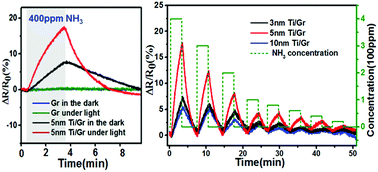Room temperature NH3 detection of Ti/graphene devices promoted by visible light illumination†
Abstract
3, 5 and 10 nm thick Ti decorated chemical-vapor-deposition (CVD) grown graphene devices (Ti/Gr) for NH3 detection were fabricated, and their sensing performances were tested at room temperature in the dark, and under visible and UV light illumination. It was found that Ti was naturally oxidized to Ti4+ for 3 nm, Ti4+ and Ti3+ for 5 nm, Ti4+, Ti3+ and Tiδ+ (0 < δ < 3) for 10 nm. Titanium oxides greatly improved the sensing performance of the Ti/Gr devices in the dark, which could be ascribed to the strong interactions among titanium oxides, NH3 and graphene. Visible light illumination further enhanced their NH3 sensing performances by different degrees, which were related to different Ti valences in titanium oxides. The best sensitivity of 17.9% and the recovery time of 2.7 min were achieved for the 5 nm Ti/Gr device under visible light illumination. Lower valence Ti in titanium oxides narrowed the optical band gap which enabled visible light to excite electron–hole pairs. This, along with graphene as the predominant conduction path, accounts for the highest sensitivity of the 5 nm Ti/Gr device. Intriguingly, visible and UV light illumination led to the opposite change of device resistance. The present study suggests that the performance of a gas sensor can be enhanced by visible light illumination by narrowing the band gaps of sensing materials. Visible instead of ultraviolet light irradiation favors practical applications of sensors because of their low cost and convenience both in fabrication and use.


 Please wait while we load your content...
Please wait while we load your content...